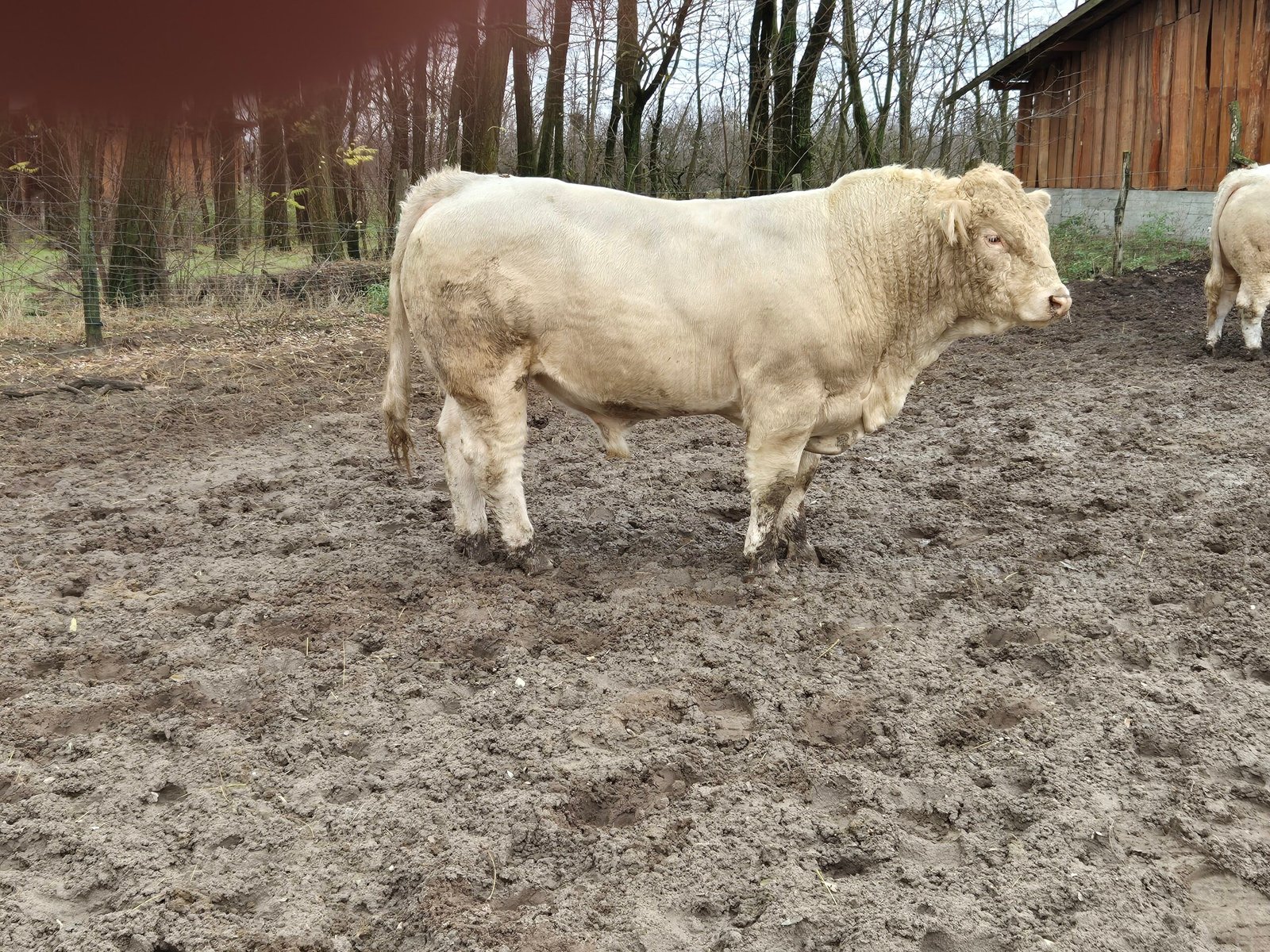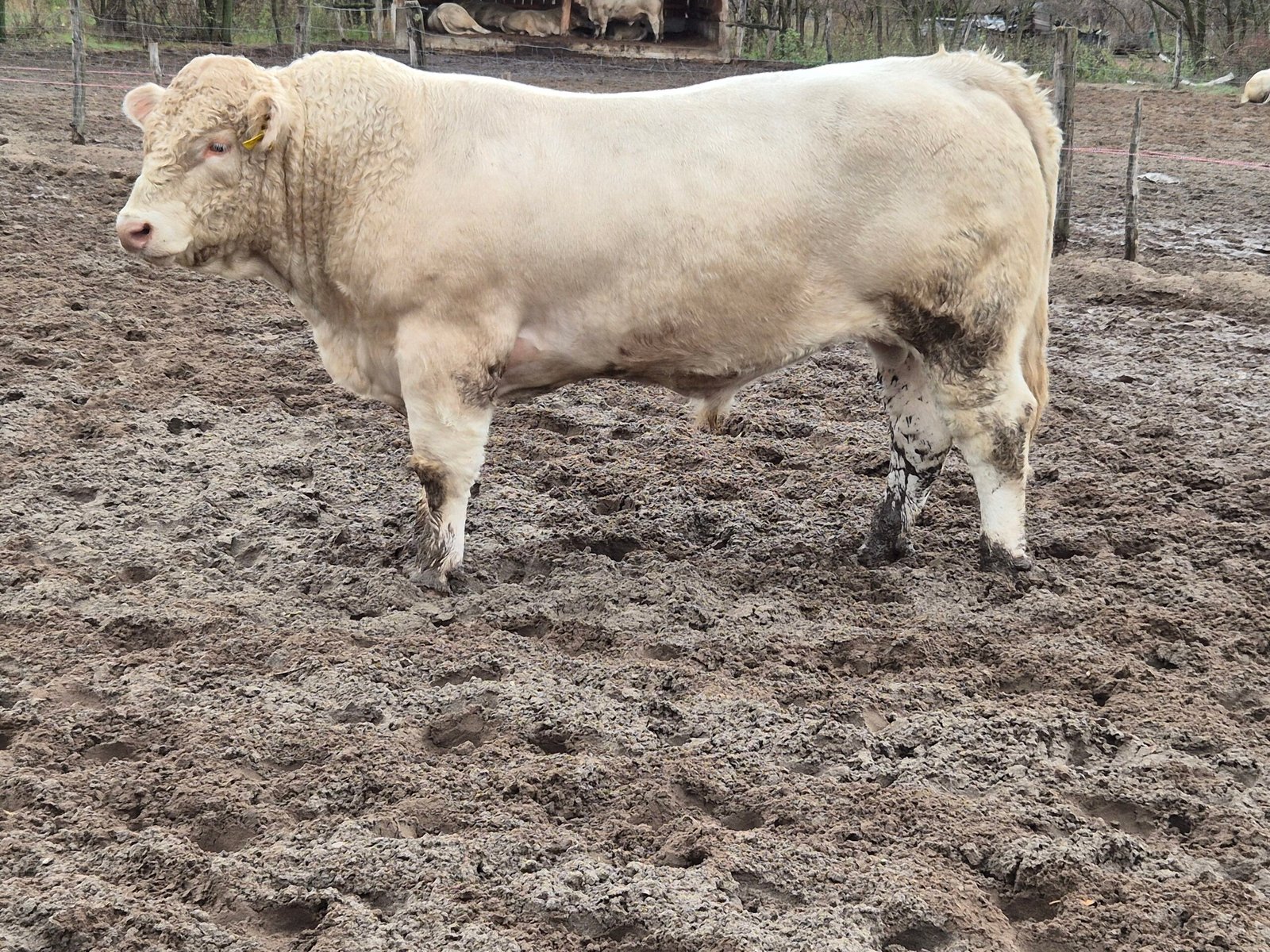The greatest strength of the Charolais variety is its rapid growth. Of course, there are big differences within the breed. According to a British study based on 8,000 individual records, the average difference between the different varieties was 225 kg and the largest difference within a variety was 525 kg.
Of course, environmental factors also play a big role in this. A big advantage of the breed is its good grazing ability and good utilisation of mass forage.
Completely white, possibly creamy, without a spot, the most apt name is "sour cream". There are also occasional variegated charolais, as an atavistic throwback, but this is very rare. However, the colour of the variety is not genetically stable. This becomes evident in crosses: some Charolais bulls consistently inherit the white colour, while other bulls do not produce crossbred offspring of uniform colour. Other appearance characteristics are given in the following tables.
Average body sizes of Charolais bulls and cows (Source: Bodó, 1979)
| Body sizes | Bull | Cow |
|---|---|---|
| height (cm) | 140 - 145 | 132 - 138 |
| Belt size (cm) | 240 - 250 | 200 - 230 |
| chest depth (cm) | 80 - 82 | 73 - 78 |
| stem circumference (cm) | 26 - 27 | 21 - 22 |
| Body landscape | Feature of |
|---|---|
| nasal mucosa | uniform clear, without stains |
| Head | proportionally broad forehead, straight head, round white horn, broad muzzle |
| Strain | deep chest, rounded deep ribs, horizontal very muscular back, wide and muscular loins, slightly "blurred" but wide external hip angle, muscular and well rounded rump and sloping thighs, belly line parallel to the back line |
| tail | without prominence, explicit |
| foot, foot tip | well structured but not too fine boned |
| Skin | very flexible, can be folded |
In the Hungarian Grey F1 herd, for example, the offspring of the bull Printemps, which was successfully crossed at the Hortobágy State Farm in 1960 and has not been published, were completely mixed in colour, but Pinard consistently passed on the colour of the breed to all his offspring without exception. This is of course significant as long as the sale is made alive.
Charolais belongs to the large cattle breeds. The average adult cow weighs 700-750 kg, the average bull 1100-1200 kg. In addition, it is not uncommon to see cows weighing 1200 kg and bulls weighing 1600 kg at shows. However, the breed also excels in maternal traits (light breed: 92%, birth weight of bull calves: 48 kg, birth weight of bull calves: 120 days old, 179 kg) (Landrieu, 2002).
Its calm, almost melancholic nature makes it stand out from the other breeds, which is why it is easy to handle. As a result, beginner beef cattle breeders have relatively few problems. It is not undemanding, but it is a "tolerant" breed. This is evidenced by the fact that it can be successfully bred in extreme climatic conditions in countries such as Spain, Mexico and South Africa. Some areas of the USA and Hungary with severe drought conditions are examples of this (Domokos, 2000).
The Charolais evolved from a local breed in the Jura mountains. The ancient variety, compared to the modern one, was a lean, mixed-muscled beef and was a variegated colour. It was kept primarily for its meat, but was also milked and bred. From the 18th century onwards, its yoke characteristics began to be developed. Selection was started to increase body size for greater yawing capacity. Later on, the Durham (now called Shorthorn) was bred for early maturity. This crossing, in addition to early maturation, resulted in greater fat gain and uniformity of white colour in the breed. From the mid-19th century onwards, a vigorous and successful selection was carried out in pure breeding to eliminate the increased amount of tallow (Bodó, 1979).
In 1864, the breed's herd-book organisation was set up in Nevers and in 1882 in Charolles, which were merged in 1920. Nevers became the centre, and Charolles gave the breed its name.
The breeding has increasingly focused on meat production. The breeding objective was to improve the shape of the meat, increase the muscling, reduce the amount of fat and shorten the legs, taking care to maintain good grazing ability. Since 1952, a production control organisation has been in operation. This work is carried out by inspection cooperatives throughout the country, under the guidance of the breed's Nevers centre (Merielle and Vannuier, 1994).
In France, two large breeding areas have been established, one in the Massif Central (departments of Nievre, Allier, Saone et Loire, Creuse) and the other in the western Atlantic (Vendée). More recently, the variety has spread to other areas of the country, such as the foothills of the Pyrenees and the hilly areas of the west. The Charolais is now a world variety. The Charolais was first exported in 1885 and has since spread throughout the world. Self-estimating artificial insemination stations keep Charolais bulls and market the semen of this world leader in lean meat production (Bodó, 1979).
It was mainly after the Second World War that the impact of this variety increased in the world, with technological advances, transport and the solution of deep-freezing of semen. Today, there are significant populations of this variety in all European countries, the United States, Canada, Mexico, Russia and the successor states of the Soviet Union, but also in South Africa and Australia.
The calf is the only yield of beef cattle, so the calving season requires the most professional attention to ensure a live birth and to keep the calves born.
Cattle farming is most developed where intensive grassland grazing is practised. Consistent feed intake is the basis for consistent animal production. The best - albeit labour-intensive - way to achieve this is to graze the animals at daily rations. Grazed grass is the most valuable because all the vitamins, essential oils and active ingredients of medicinal plants are much better utilized by grazing than by silage or acidification. Less efficient feeding. Of all forms of beef production, pasture grazing has been found to be the best and cheapest.
The production of breeding bulls is mainly carried out by the herdsmen who have been involved in the naturalisation of the breed since its inception. Only animals meeting the requirements are registered for the selection of breeding bulls. These standards often relate not only to the known pedigree, but also to the bull's appearance and the requirements to be met.
Perhaps we are beyond the debate about which is better, hornless or horned genetics. The market demand for genetically hornless Charolais breeding stock is almost insatiable.
The Charolais is also indispensable as the finishing line of the different breeds in purebred breeding. We are moving the development of our genetically unpolled herd towards homozygous lines, so that all offspring are genetically unpolled in a predictable rather than random way. There are very few good quality homozygous hornless breeding stock on the market, so we have purchased homozygous embryos from Canadian and American lines, and have also washed embryos from the outstanding individuals in our own breeding stock, so we have implanted nearly 100 embryos to accelerate the development of this genetics. As of next year, we have 11 homozygous hornless bulls covered on our gilts and we have more and more animals to offer for sale from this construction.
Some thoughts on the hornless inheritance:
For more than a decade, the cattle gene map has been known, including which gene pairs (alleles) are responsible for which traits. Thus, the allele of dunginess is also known.
In the international nomination:
If the dominant gene P is present in the gene pair (PH) then the individual is always hornless Horned animals are always homozygous for the gene pair at this time (HH).
Case 1:
bull = HH (hornalt)
cow= PH (heterozig, hornless)
offspring:
In this case, 50% heterozygous hornless 50% horned.
Case 2:
bull = HP (heterozig, hornless)
cow= PH (heterozig, hornless)
offspring:
In this case the distribution of the offspring is 25% horned 50% heterozygous hornless 25% homozygous hornless.
Case 3:
bull = PP (homozig, hornless)
cow= HH (hornalt)
4 offspring with different genotypes:
If we use homozygous hornless bulls for the horned herd, all the subsequent heterozygotes will be hornless!
WHERE THE HORN OF CHARACTER IS A BARRIER TO MARKETABILITY:
Back in the mid-1980s, we were fattening a significant number of Charolais X Hungarian Grey bulls. The weight gain results were very good (1200-1500 gr/day under those conditions).The only problem was that the Hungarian grey bulls had beautiful horns, but the buyers did not appreciate this. This is still the case today with this crossbreeding construction!
Since then, the Hungarian Grey herd, which has grown to a significant size (7-8 thousand), may be one of the breakout points of the market problems of the homozygous hornless Charolais bull as a crossbreeding partner in non-nucleus breeding.
We have light-breasted hornless Charolais bulls with outstanding conformation, which can bring a significant improvement in results for the grey farmer.
And of course, some of the Hungarian grey nucleus population will have to start a very hard selection to improve meat forms and growth vigour, SO THAT THIS FARM CAN BE HELD BACK when the extra support runs out.
Márton Bujdosó

